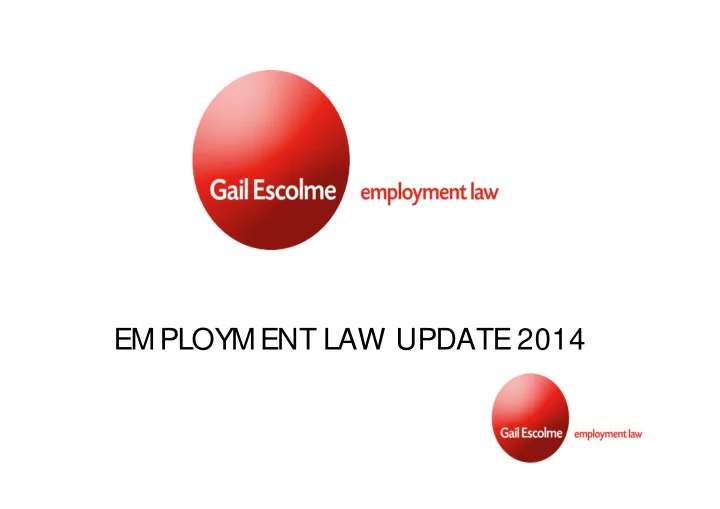

EM PLOYM ENT LAW UPDATE 2014
CONTENTS • EARLY ACAS CONCILIATION • PENSION AUTO ENROLM ENT • ZERO HOUR CONTRACTS • WORKING TIM E REGULATIONS AND HOLIDAYS
ACAS EARLY CONCILIATION • Will launch on 6 th April 2014 • Compulsory for tribunal claims lodged on or after 6 th M ay 2014 • Tribunal claims will not be accepted unless complaint referred to ACAS and a conciliation certificate issued. • ACAS will make “ reasonable attempts” to contact the parties.
ACAS CONCILIATION • NO REAL TEETH • TAKE CARE AS EM PLOYER – CONSIDER CAREFULLY BEFORE DISM ISSING IDEA
PENSION AUTO ENROLM ENT • KNOW YOU STAGING DATE • PRE PLAN YOUR STRATEGY FOR INTRODUCING AUTO ENROLM ENT • IDENTIFY WHO WILL AUTO ENROL ON YOUR STAGING DATE • NOTIFICATION
AUTO ENROLM ENT • CONTRACTS OF EMPLOYM ENT – Review your contracts and include auto enrolment clauses where appropriate, e.g – “ The Company will comply with the employer pension duties in respect of the Employee in accordance with Part 1 of the Pensions Act 2008” – This clause would be used on the automatic enrolment of all new joiners. • If you have a qualifying occupational pension scheme in place then this would satisfy the auto enrolment requirements for all those employees within the scheme
Auto enrolment and M aternity, Paternity Leave etc. • Employees who take maternity, paternity parental or adoption leave are protected by statute with regard to their pension entitlement during the period of leave. • During OM L an employee is required to continue to contribute to her pension (assuming the scheme is contributory in the first place) on the basis of the pay she actually receives. • Working on the principle of a money purchase scheme, you, the employer, would be required to continue to pay your normal contributions based on the employee’s normal salary
Auto enrolment and M aternity, Paternity Leave etc. • AM L – Employer contributions would only be payable during a period of AM L if the scheme rules or contract dictate it. In most circumstances no payment would be required by the employer during AM L. • The employee is not required to contribute during a period of AM L.
NOTIFICATION • PREPARE STANDARD FORM DOCUM ENTS INCLUDING OPT OUT AND OPT IN NOTICES • REM EM BER THAT THOSE WHO CHOOSE NOT BE IN THE PENSION SCHEM E WILL BE AUTOM ATICALLY RE-ENROLLED AFTER 3 YEARS – DIARY ON! • ENSURE YOU AND YOUR STAFF UNDERSTAND WHAT IS GOING TO HAPPEN
ZERO HOURS CONTRACTS • No legal definition. A zero hours contract normally means there is no obligation upon the employer to offer work, nor on the worker to accept it. • Usually used to provide a flexible workforce, eg; – To cover last minute or unexpected events – For temporary staff shortages – For on call/ bank work
Zero hours contracts • Other alternatives should be considered, e.g. – Agency Workers – Provision of Fixed Term Contracts – Annualised hours contracts Whether there are breaks in the employment will depend on the specifics of the agreement. It may be agreed that a contract only exists when work is provided. However there must be one full week without work to show the break in employment.
Zero hours contract • Alternatively agreement could be reached that the worker remains employed for the duration of the employment, whether they work in any particular week or not. • Regardless – all workers will still be entitled to holiday pay when the employment is broken. • Be careful – custom and practice may apply.
WORKING TIM E REGULATIONS HOLIDAYS • All full time employees, i.e. working 5 days or more per week, are entitled to a minimum of 28 days leave per year, including bank holidays, pro rata for part time staff. • The employer can refuse to allow holidays to be taken until enough has been accrued. • Employers can dictate when holidays can be taken and can specify certain times of the year when no holidays will be authorised as long as all holidays have been taken by the end of the holiday year and refusal to allow holidays is not discriminatory.
Holidays • Holiday pay should include overtime. Essentially employees should be paid that which they would have received if they had been at work. • If employees hours of working differ each week, you can calculate holiday entitlement in hours, calculating 12.07% of each hour worked as holiday. • Payment can only be made for holidays upon termination of employment. It is illegal to pay employees for holidays not taken in the holiday year.
HOLIDAYS • Contracts of employment should include a clause allowing the employer to deduct holidays taken but not accrued on termination. • By statute employees should give twice as much notice of the holiday required, e.g. if they want 1 week’s holiday they should give 2 week’s notice. The employer can refuse holidays by giving twice as much notice as the holiday required, e.g. if the employee applies for 1 week’s holiday and the employer cannot accommodate it, it should inform the employee at least 2 weeks before.
Holidays • Holidays continue to accrue through maternity, paternity and adoption leave. • Holidays continue to accrue through sickness. Employees are entitled to apply for holidays whilst signed off sick, but cannot be off sick and on holiday at the same time, therefore they would be paid holiday pay only through the holiday period and would then go back to sick pay at the end of that period.
CONTACT DETAILS GAIL ESCOLM E SUNNYSIDE GRANGE VIEW WARTON CARNFORTH LANCASHIRE LA5 9HL TEL: 01524 735525 E: gail@gailescolmelegal.co.uk W: www.gailescolmelegal.co.uk
Recommend
More recommend